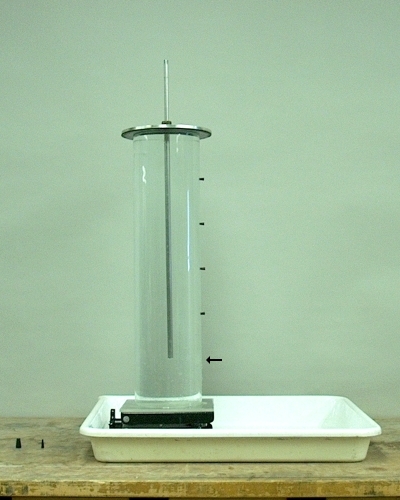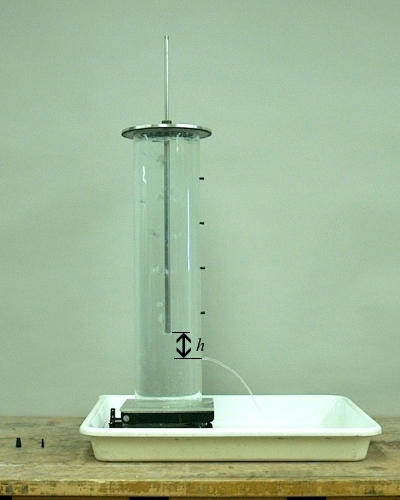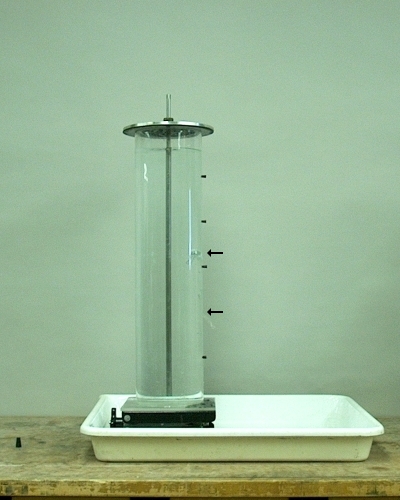
Design courtesy of Prof. Jim Allen
Besides the steel inlet tube (shown above), a glass inlet tube is also available, and is normally the one used.
The Mariotte bottle (also called a Mariotte siphon) is a device that allows one to deliver a liquid at a constant (adjustable) pressure. As long as the liquid remains above the bottom of the tube that determines the exit pressure (vide infra), the pressure remains constant regardless of the level of the liquid in the delivery vessel. This ingenious device was invented by Edmé Mariotte, a 17th-century French physicist. (See also here, a Wikipedia entry here, and a Wikipedia note on the Mariotte bottle here.)
The Mariotte bottle is a vessel that is closed except for an opening at the top for an inlet tube, and an opening, either at the top or elsewhere, for an exit tube. In the device shown in the photograph above, the metal plate makes an airtight seal to the top of the plastic cylinder via a greased rubber gasket, and the inlet tube passes through the plate via a compression fitting that seals with an o-ring. Instead of an exit tube, this device has a series of holes in its wall, all plugged with rubber stoppers, except for the lowest, whose location is shown by the arrow in the photograph. Another design has the exit tube coming through the top plate, parallel to the inlet tube, then bent over to run down beside the vessel, with the end at some height below that of the bottom of the inlet tube. The end of the exit tube can be anywhere below this, extending to levels below the vessel itself. The bottle in this configuration is sometimes called a Mariotte siphon, since the water flowing out of the bottle takes a similar path to that in a siphon.
Initially, when you fill and seal the bottle, water fills the tube to the same height as the level inside the cylinder. Unless you fill the bottle completely with water, there is some air above the water, and the pressure at the bottom of the tube, Pref = ρgh0 + Pspace, where ρ is the density of water, g is the acceleration of gravity, h0 is the difference in height between the top of the water and the bottom of the tube, and Pspace is the pressure in the space above the water. When one of the holes is opened, water flows out of the bottle until Pspace falls to where it equals atmospheric pressure minus ρgh0, the pressure exerted by the water column. At this point, the water inside the tube has fallen to the bottom of the tube, and the pressure at its bottom opening equals atmospheric pressure. (h0, of course, decreases slightly during this process.)
In the photograph above, the bottom of the tube is level with the bottom hole, whose stopper has been removed. The pressure at the bottom of the tube is atmospheric pressure, and the pressure outside the open hole is atmospheric pressure. Since the tube is level with the hole, there is nothing else exerting pressure (or lowering it) at the hole, and no water flows.
Next, we raise the inlet tube, as in the photograph below:

Now there is a column of water of height, h, as marked in the photograph above, between the bottom of the inlet tube and the exit hole. The pressure at the bottom of the inlet tube is still atmospheric pressure, but now the pressure inside the exit hole exceeds atmospheric pressure by ρgh, and water now flows out of the exit hole. As soon as water begins flowing out of the exit hole, the pressure inside the vessel decreases, causing the pressure at the bottom of the inlet tube to fall below atmospheric pressure. This causes air to enter the tube, keeping the pressure at the bottom of the tube at atmospheric pressure. Thus, as long as the level of water inside the cylinder is above the bottom of the inlet tube, the pressure at the exit hole will remain constant at ρgh. The air that enters the system bubbles from the bottom of the tube to the space at the top of the cylinder, as you can see in the photograph above.
Now we'll see what happens if we lower the tube so that its lower end is below the open hole:

In the photograph above, the end of the tube is nearly at the bottom of the apparatus, the bottom hole is plugged, and the second hole from the bottom is open (at the lower arrow in the photograph). Since the system was allowed to equilibrate as described above, before the stopper was pulled, the pressure at the bottom of the tube was one atmosphere. For this process, the bottom of the tube was level with the lowest hole, so the pressure on both sides of that hole is thus one atmosphere. (It makes no difference that the bottom of the tube is now lower than this; the bottom of the tube now contains water up to the level of the lowest hole. I should have realized that when I was making the photograph!) The pressure at the second hole from the bottom is lower than this by the difference between the height of the water column exerting pressure on it and the height of the water column exerting pressure on the bottom hole. This difference is just -ρgh, where h is now the distance between the two holes. The pressure at the second hole from the bottom is thus lower than one atmosphere, and when the stopper is removed, air enters through the hole until the pressures inside and outside the hole are equalized at one atmosphere. The upper arrow in the photograph shows a bubble of air that has entered the hole, on its way to the top.
References: